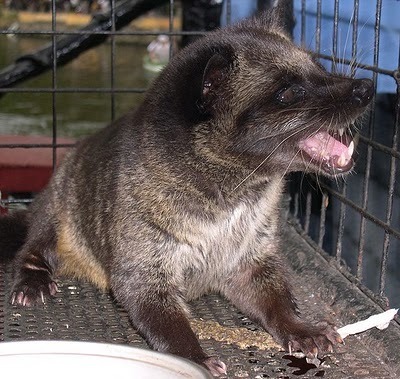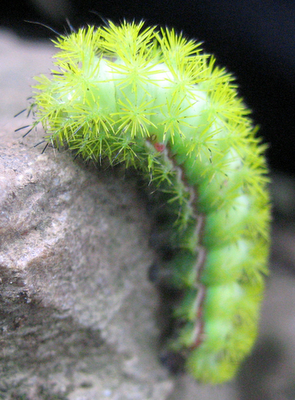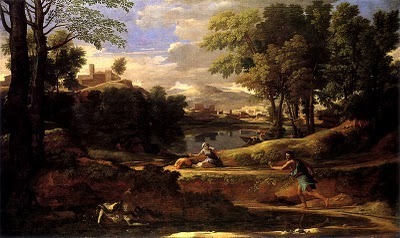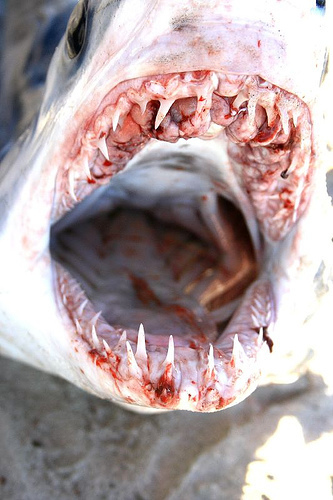Gordon Grice's Blog, page 98
March 7, 2011
More on the mystery animal scare in India
Mystery animal scare in Memco , News - City - Ahmedabad Mirror,Ahmedabad Mirror:
More about the attack on 20 people Thursday night. The article has photos and interviews with a couple of the victims.
"Rejecting the idea that it could have been a domestic cat or dog, Zoo Superintendent R K Sahu said, "The behaviour and attacking pattern indicate the animal could have been a palm civet. It has to be a nocturnal creature prowling for food. Civets have a tendency of attacking the head and neck. Its claws leave deep wounds."
Explaining further, Sahu said, "The civet considers man to be his enemy as humans are an obstacle for it while gathering food especially from residential areas.""
More about the attack on 20 people Thursday night. The article has photos and interviews with a couple of the victims.
"Rejecting the idea that it could have been a domestic cat or dog, Zoo Superintendent R K Sahu said, "The behaviour and attacking pattern indicate the animal could have been a palm civet. It has to be a nocturnal creature prowling for food. Civets have a tendency of attacking the head and neck. Its claws leave deep wounds."
Explaining further, Sahu said, "The civet considers man to be his enemy as humans are an obstacle for it while gathering food especially from residential areas.""
Published on March 07, 2011 10:04
Moe on the mystery animal scare in India
Mystery animal scare in Memco , News - City - Ahmedabad Mirror,Ahmedabad Mirror:
More about the attack on 20 people Thursday night. The article has photos and interviews with a couple of the victims.
"Rejecting the idea that it could have been a domestic cat or dog, Zoo Superintendent R K Sahu said, "The behaviour and attacking pattern indicate the animal could have been a palm civet. It has to be a nocturnal creature prowling for food. Civets have a tendency of attacking the head and neck. Its claws leave deep wounds."
Explaining further, Sahu said, "The civet considers man to be his enemy as humans are an obstacle for it while gathering food especially from residential areas.""
More about the attack on 20 people Thursday night. The article has photos and interviews with a couple of the victims.
"Rejecting the idea that it could have been a domestic cat or dog, Zoo Superintendent R K Sahu said, "The behaviour and attacking pattern indicate the animal could have been a palm civet. It has to be a nocturnal creature prowling for food. Civets have a tendency of attacking the head and neck. Its claws leave deep wounds."
Explaining further, Sahu said, "The civet considers man to be his enemy as humans are an obstacle for it while gathering food especially from residential areas.""
Published on March 07, 2011 10:04
March 6, 2011
Palm Civet Attacks

In India, officials are trying to trap an animal that mauled 20 people in one night. The prime suspect is a palm civet.
Civets and palm civets are little known in the West, but very common in much of Asia and Africa. Though they're all among the carnivorids (related to dogs, cats, hyenas, and so on), they comprise several families. Despite their lack of fame, various kinds of civets are economically important. Some of them make a stinky fluid to mark their territories. This fluid is used as a base for some perfumes. People harvest the fluid by scraping it out through a certain orifice. I'm told the civet does not enjoy the procedure.
In a certain kind of civet, the glands that make this fluid look like testicles, which means both genders appear to be equipped as males. This particular species helps make gourmet coffee. The civet eats the fruit of the coffee plant, digests most of it, and defecates the seeds (or beans). Supposedly coffee beans that have gone a progress through the guts of a civet yield extraordinarily rich, flavorful coffee. It sells for better than $100 a pound, though not at my local Cub Foods.
Back in 2003, a respiratory disease called SARS burst onto the scene, spreading rapidly across the globe from its Southeast Asian origins and just as rapidly dwindling as governments across the world imposed quarantines and restricted imports. Its mortality rate approached an extraordinary ten percent. Scientists found the virus in various animals, including bats and black rats, but no one knows how it passed to people. The US government banned the import of civets on strong circumstantial evidence linking a palm civet (Paguma larvata) with the disease. Animal handlers and restaurant workers who prepared wild animals showed high rates of infection.
Anyway, civets are all small; the likely species in these Indian attacks tops out at under 15 pounds. So this one probably isn't trying to prey on people. It's more likely a case of crowding--lots of people and animals wanting the same space and the same food.
Published on March 06, 2011 10:01
March 2, 2011
Io Moth

Here's the caterpillar of an io moth, which has mildly toxic bristles. A touch can cause a minor rash. I get a lot of comments about the surprising dangers mentioned in Deadly Kingdom, including a few moths and butterflies that can do more than irritate. Some have put people in shock.
Most butterflies and moths are harmless, of course. Here's an expanded version of the slideshow "Butterflies and Moths of Wisconsin," featuring (mostly) the work of photographer D'Arcy Allison-Teasley. I first ran this back in July, and it proved to be one of one of our more popular slideshows.
Sphinx Moth2. Painted Lady Butterfly 3. Eastern Tiger Swallowtail Butterfly male 4. Eastern Tiger Swallowtail Butterfly female 5. Mourning Cloak Butterfly 6. Some sort of sphinx, I think? IDs welcome.7. Nessus sphinx. Thanks to AT for the identification.8. Anybody know what this one is? 9. Monarch Butterflies. This one is by D'Arcy's dad, Wayne Allison.
Published on March 02, 2011 20:08
February 26, 2011
Beetles of Laos
Interesting insects that look lsomewhat like larvae even though they have their adult legs. "Neoteny" means retaining youthful characters into adulthood. I talked some about this phenomenon in The Red Hourglass.
Published on February 26, 2011 12:07
February 19, 2011
Landscape with a Man Killed by a Snake

Mark Dery pointed me to this painting by the 17th Century French artist Nicolas Poussin. Hard to see just what the snake in the foreground is doing here, but thankfully we have the title to help us: Landscape with a Man Killed by a Snake. (The link will take you to the National Gallery's website, which offers a little background.) I've never seen a Poussin painting in person, but to judge by what I see online, the guy has serious problems matching tone with material. Over on Art Renewal, for example, I see a lovely painting of a fellow getting disemboweled, and a delicately colored view of a guy stomping on a baby. I'm finding this snake one inappropriately beautiful as well.
More animals in art:
Published on February 19, 2011 13:25
Landscape with a Man Killed by Snake

Mark Dery pointed me to this painting by the 17th Century French artist Nicolas Poussin. Hard to see just what the snake in the foreground is doing here, but thankfully we have the title to help us: Landscape with a Man Killed by a Snake. (The link will take you to the National Gallery's website, which offers a little background.) I've never seen a Poussin painting in person, but to judge by what I see online, the guy has serious problems matching tone with material. Over on Art Renewal, for example, I see a lovely painting of a fellow getting disemboweled, and a delicately colored view of a guy stomping on a baby. I'm finding this snake one inappropriately beautiful as well.
More animals in art:
Published on February 19, 2011 13:25
February 15, 2011
Dangerous Snakes of the World
These are antique illustrations of dangerous snakes. The first three are big constrictors, the rest venomous. Amazing how many variations nature has played on the basic design of a tube.
Published on February 15, 2011 11:26
February 10, 2011
The Old Man and the Sharks
 Mouth of a mako shark
Mouth of a mako sharkI've recently re-read Earnest Hemingway's The Old Man and the Sea. Among its many other virtues, the book does a great job of describing its wildlife. Here's Hemingway's description of a mako shark:
He was a very big Mako shark, built to swim as fast as the fastest fish in the sea and everything about him was beautiful except his jaws. His back was as blue as a sword fish's and his belly was silver and his hide was smooth and handsome. He was built as a sword fish except for his huge jaws which were tight shut now as he swam fast, just under the surface with his high dorsal fin knifing through the water without wavering. Inside the closed double lip of his jaws all of his eight rows of teeth were slanted inwards. They were not the ordinary pyramid-shaped teeth of most sharks. They were shaped like a man's fingers when they are crisped like claws. They were nearly as long as the fingers of the old man and they had razor-sharp cutting edges on both sides. This was a fish built to feed on all the fishes in the sea, that were so fast and strong and well armed that they had no other enemy.
Hemingway also intrigues me with what his character calls shovel-nosed sharks. That name has been applied to various species, including such dangerous ones as the bull shark and the dusky shark. But none of those quite fits Hemingway's description. Critic Susan F. Beegel points out that what does fit his description is the oceanic whitetip. This species, a member of the requiem family, is known to take victims of shipwrecks. In Deadly Kingdom, I mentioned a diver who was fatally mauled by a pair of whitetips.
He could see their wide, flattened shovel-pointed heads now and their white-tipped wide pectoral fins. They were hateful sharks, bad smelling, scavengers as well as killers, and when they were hungry they would bite at an oar or the rudder of a boat. It was these sharks that would cut the turtles' legs and flippers off when the turtles were asleep on the surface, and they would hit a man in the water, if they were hungry, even if the man had no smell of fish blood nor of fish slime on him.
 An oceanic whitetip shark with his hangers-on
An oceanic whitetip shark with his hangers-onBut the main nonhuman character in Hemingway's book is a huge marlin. Here's an earlier post featuring an amazing photo of a blue marlin.
Published on February 10, 2011 10:46
February 7, 2011
Cobra Bite: "You Can See It's Not Very Happy"
The latest exotic pet trouble occurred in New Jersey, where a man was bitten by his albino monocled cobra. He's in serious condition. Several other animals, including a rattlesnake, can be heard in the background of his homemade video. The cobra has its hood spread throughout this video. That's its threat display, indicating that it does not approve of being filmed.
Cobra bite victim recovering as probe of snake purchase continues - NorthJersey.com
Published on February 07, 2011 03:06



